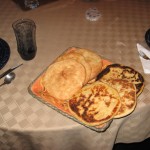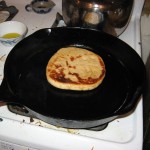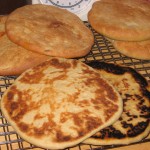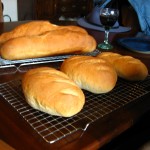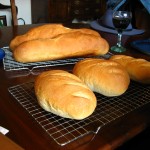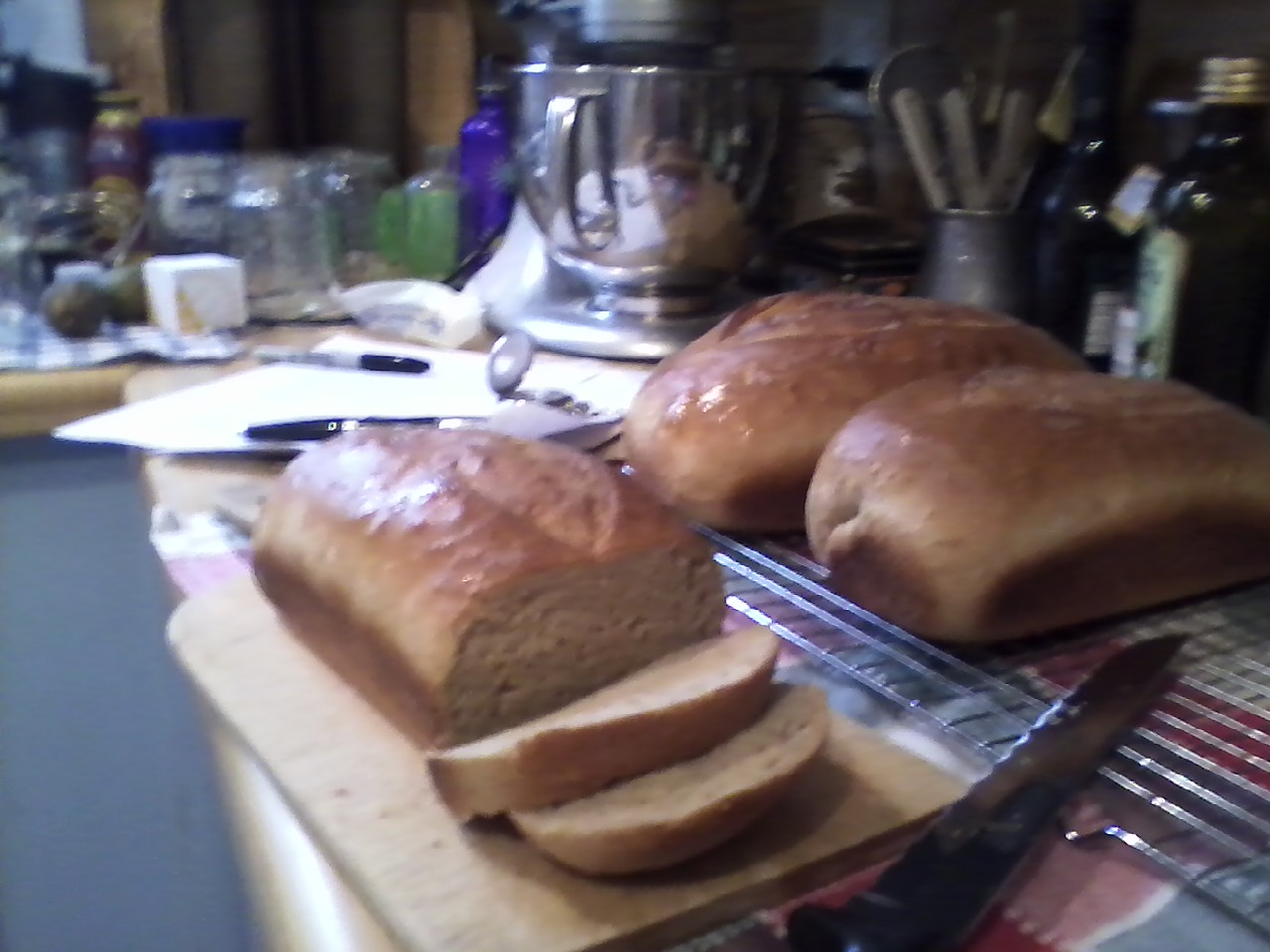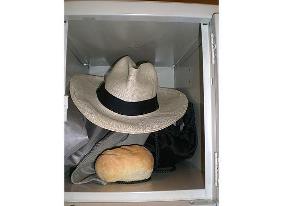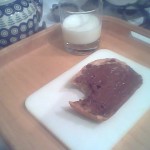 “Some look at the world as it is,
“Some look at the world as it is,
and they ask: ‘Why?’
I look at the world,
and I ask: ‘Wouldn’t it be great to have a dark chocolate and peanut butter sandwich on cherry bread?
I wonder how you make cherry bread?'”
(This is a variation of my Cherry Pistachio Bread)
Ingredients:
- 1 1/2 cups warm water
- 1 cup warm milk
- 1/2 cup Almond Meal (optional)
- 6-7 cups, give or take, of whole wheat (3 cups) and bread flour (4+ cups)
- 1 Tbsp. Jam (preferably cherry, but today I used apricot)
- 1 1/2 Tbsp. Yeast (maybe 3 envelopes?)
- 1 Tbsp. Salt
- 1 Tbsp. Almond flavour
- 3/4 cup Dried Cherries
- 1 cup Chopped Almonds
- 1 Egg (you need the white)
Step 1, Wet Stuff: In a large bowl (or the mixer bowl if you plan on letting the bread hook to the heavy lifting); whisk the Jam into the warm Milk and the first half cup of warm Water. Add the dried Cherries, and set to the side.
Step 2, meanwhile, back at the yeast: in a smaller container, whisk together the remaining cup of warm Water, the Yeast, and just a smidge of the Jam. Let this sit for a few minutes (listen to a pop-song, gather the flour, begin to chop the almonds whatever you fancy), and let it start to bubble.
Step 3, mixing and proofing: Whisk the yeast mi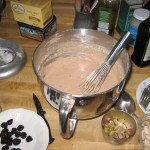 xture into the milk mixture. Next, add in the first 2 cups of flour a little bit at a time, whisking until it is smooth–I usually move from the coarsest flour to the smoothest, so the wheat flour here. Now leave this in a warm place for 5 minutes and walk away. Fold laundry, try to figure out where you put the bread flour, dance, just leave the yeast alone.
xture into the milk mixture. Next, add in the first 2 cups of flour a little bit at a time, whisking until it is smooth–I usually move from the coarsest flour to the smoothest, so the wheat flour here. Now leave this in a warm place for 5 minutes and walk away. Fold laundry, try to figure out where you put the bread flour, dance, just leave the yeast alone.
Step 4, kneading: Come back, Little Sheba. If it is bigger, and a little poofy, the yeast is doing great. If not, either you have bad yeast or a cold spot. Whisk down this living thing in the bowl, and add 1 Tbsp of Salt & 1 Tbsp Almond Flavor. Add in the Bread Flour 1/4 of a cup at a time, and thoroughly mix it in; when the whisk becomes impractical, use a big wooden spoon, when this is too hard, use a mixer with a bread hook or turn it our onto a floured surface.
It is important to knead the flour in 1/4 of a cup at a time, and after each bit of flour, hook or knead the bread until it becomes one thing again–not a mixture of flour and dough, but one unit. When the dough is a single round thing holding on to itself and not sticking to other things, behaving about like a deflated volley ball, it is ready. The amount of the flour doesn’t matter–getting it to this proper consistency is what matters. Roll it around on the counter for good measure.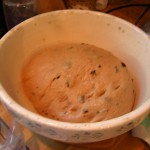
Step 5, let it rise: Grease a smooth bowl 3 times as big as the dough. Roll the dough ball in the oil, and then cover with plastic wrap or a wet towel or something that will let it work without drying out. Let this sit in a warm place–in the oven with a heating pad on a different shelf, on the sunny side of the house, just a safe and warm place–until the dough has doubled in size. Usually, this will be about an hour.
Step 6, making loaves: Turn the dough out onto a clean 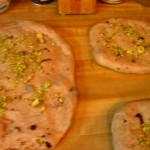 surface, and punch it down (forcefully knead it), which should reduce it to close to its original size. Separate this into 2 portions (or 3 or 4 or… you figure it out). Flatten each of these, and sprinkle with the first 3/4 cup of Almonds. Fold the dough back into itself, knead it slightly and shape each into loaves; make sure that there are not seams or spots the loaf might separate, maybe pinching loose edges and rolling it about a bit–each should be smooth and coherent–it’s own little self.
surface, and punch it down (forcefully knead it), which should reduce it to close to its original size. Separate this into 2 portions (or 3 or 4 or… you figure it out). Flatten each of these, and sprinkle with the first 3/4 cup of Almonds. Fold the dough back into itself, knead it slightly and shape each into loaves; make sure that there are not seams or spots the loaf might separate, maybe pinching loose edges and rolling it about a bit–each should be smooth and coherent–it’s own little self.
Step 7, second rising: Grease some baking sheets and sprinkle with corn meal, or grease 3 bread pans, or 2 bread pans and 2 little pans, or some such combinations. Put each loaf into a pan, slit along the top with a sharp knife (this lets bubbles out) and set these into a warm place until they have grown–usually less that the first rise. About half way through this rise (20? 25 minutes?) pre-heat the oven to 400 degrees.
Step 8, prepping and baking: Beat together an Egg White and a little cold water. Paint the tops of the loaves with the egg white mixture, and then sprinkle with the remaining Almonds. Put the bread in the oven for 30 or 35 minutes, until the top crust is a nice dark brown. Figure out your oven, and see if you need to turn them or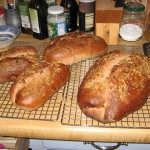 rotate them to get them to cook evenly.
rotate them to get them to cook evenly.
Step 9, cool it, boy: When they are done, get them out, take them off the sheets or out of the pans, and put them on a cooling rack.
Last Step, sharing: You may have noticed I made several loaves. You can, of course, use division and figure out how to make a smaller batch, but I suggest you make more, and then figure out why you needed more. The bread might be so good that one loaf is eaten before it even cools. Break out the Brown Betty; it is perfect with some butter and a cup of tea.
Most importantly, if you have extra bread, you will have to give it away. Make a present of it and Brie to an aspiring writer and cabaret star on his 30th birthday. 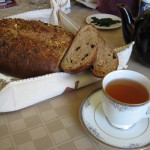 Give it to friends for Christmas, a House Warming or just because. As always, give it to a wandering through-hiker, a musician or a college student–all of these are good karma. You might give some to somebody you love, or whom you wish to love, or who needs to feel loved.
Give it to friends for Christmas, a House Warming or just because. As always, give it to a wandering through-hiker, a musician or a college student–all of these are good karma. You might give some to somebody you love, or whom you wish to love, or who needs to feel loved.
My mom says it is just as easy to pray for somebody while kneading bread as it is just to pray for somebody; I don’t understand prayer, but I know everybody needs to feel loved and everybody loves good bread.
Bonus Step, left-overs: It makes brilliant toast, of course. It also makes excellent French toast, bien sûr, if you like that sort of thing.

